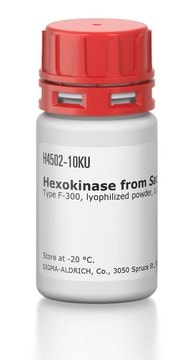S0937
Sucrose Phosphorylase
recombinant, expressed in E. coli, lyophilized powder, ≥45 units/mg solid
Synonym(s):
SPase, disaccharide glucosyltransferase, sucrose glucosyltransferase, Sucrose:orthophosphate α-D-glucosytransferase
Sign Into View Organizational & Contract Pricing
All Photos(1)
About This Item
CAS Number:
MDL number:
UNSPSC Code:
12352204
NACRES:
NA.54
Recommended Products
recombinant
expressed in E. coli
form
lyophilized powder
specific activity
≥45 units/mg solid
mol wt
56 kDa by SDS-PAGE
shipped in
wet ice
storage temp.
−20°C
General description
Research area: Cell signaling
Sucrose Phosphorylase belongs to glycoside hydrolase, GH13 family. It comprises of four domains with the glucose anomeric carbon-binding site and a glucoside-binding site. The active site residues include Asp192 and Glu232. It is majorly produced by bifidobacteria and lactic acid bacteria. The cross-linked sucrose phosphorylase aggregates is thermostable and could be exploited for industrial catalysis of glycosylation.
Sucrose Phosphorylase belongs to glycoside hydrolase, GH13 family. It comprises of four domains with the glucose anomeric carbon-binding site and a glucoside-binding site. The active site residues include Asp192 and Glu232. It is majorly produced by bifidobacteria and lactic acid bacteria. The cross-linked sucrose phosphorylase aggregates is thermostable and could be exploited for industrial catalysis of glycosylation.
Application
Sucrose Phosphorylase has been used in sucrose determination in wheat plant and in sucrose hydrogen production.
Sucrose phosphorylase has been used:
- To assess the enzymatic synthesis of stable, odorless, and powdered furanone glucosides.
- To investigate the novel transglucosylating reaction with carboxylic compounds.
- In sucrose determination in wheat plant and in sucrose hydrogen production.
Biochem/physiol Actions
Sucrose phosphorylase catalyzes the reversible conversion of sucrose (α-D-glucopyranosyl-1,2-β-D-fructofuranoside) and phosphate into D-fructose and α-D-glucose 1-phosphate. This reaction plays a crucial role in generating the vital glucose component through sucrose metabolism.(1)
Unit Definition
One unit will produce 1.0 μmole of D-fructose from sucrose per min with the corresponding reduction of NADP to NADPH at pH 7.6, at 25 °C.
Physical form
Contains sucrose as stabilizer.
Signal Word
Danger
Hazard Statements
Precautionary Statements
Hazard Classifications
Resp. Sens. 1
Storage Class Code
11 - Combustible Solids
WGK
WGK 3
Certificates of Analysis (COA)
Search for Certificates of Analysis (COA) by entering the products Lot/Batch Number. Lot and Batch Numbers can be found on a product’s label following the words ‘Lot’ or ‘Batch’.
Already Own This Product?
Find documentation for the products that you have recently purchased in the Document Library.
Customers Also Viewed
Kuniki Kino et al.
Bioscience, biotechnology, and biochemistry, 72(9), 2415-2417 (2008-09-09)
Cellobiose phosphorylase from Clostridium thermocellum catalyzed the beta-anomer-selective synthesis of alkyl glucosides from cellobiose. Synthesis of alkyl beta-glucoside from inexpensive sucrose using cellobiose phosphorylase and sucrose phosphorylase from Pseudomonas saccharophilia was investigated. By combined use of these two phosphorylases, alkyl
Christiane Goedl et al.
Journal of biotechnology, 129(1), 77-86 (2007-01-12)
Sucrose phosphorylase catalyzes the reversible conversion of sucrose (alpha-D-glucopyranosyl-1,2-beta-D-fructofuranoside) and phosphate into D-fructose and alpha-D-glucose 1-phosphate. We report on the molecular cloning and expression of the structural gene encoding sucrose phosphorylase from Leuconostoc mesenteroides (LmSPase) in Escherichia coli DH10B. The
Jin-Ha Lee et al.
Biotechnology letters, 30(4), 749-754 (2007-11-27)
The gene encoding sucrose phosphorylase (742sp) in Leuconostoc mesenteroides NRRL B-742 was cloned and expressed in Escherichia coli. The nucleotide sequence of the transformed 742sp comprised an ORF of 1,458 bp giving a protein with calculated molecular mass of 55.3
Genotypic variation in water-soluble carbohydrate accumulation in wheat
Ruuska SA, et al.
Functional plant biology, 33(9), 799-809 (2006)
Koji Nomura et al.
Bioscience, biotechnology, and biochemistry, 72(1), 82-87 (2008-01-08)
Transglucosylation from sucrose to acetic acid by sucrose phosphorylase (EC 2.4.1.7) was studied. 1-O-Acetyl-alpha-D-glucopyranose was isolated as the main product of the enzyme reaction. We also compared the pH-dependence of transglycosylation catalyzed by sucrose phosphorylase toward carboxyl and hydroxyl groups.
Our team of scientists has experience in all areas of research including Life Science, Material Science, Chemical Synthesis, Chromatography, Analytical and many others.
Contact Technical Service









